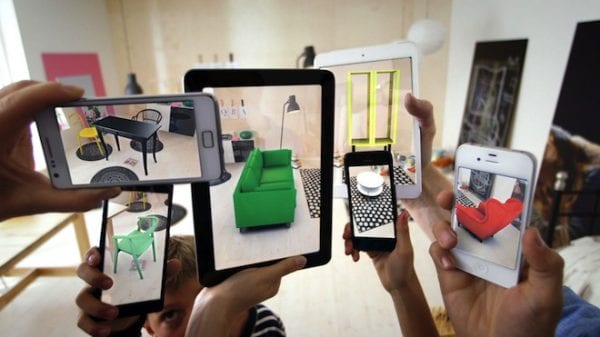While flying cars and rocket boots are still in the works, augmented reality is an existing technology taking us one step further into the future.
Much like its relative virtual reality (VR), which moves you completely into a simulated world most notably by the use of goggles, augmented reality (AR) is a technology that overlays virtual elements into a physical environment, enabling a dynamic manipulation of data into the world around us. With the AR market projected to reach $117.4 billion by 2022, this is not just a trend on the rise, but a technological mainstay that looks to streamline communications and enhance the bottom line.
While AR has been used most widely in industries like retail, medical research, real estate, and sports (think to when the camera zooms in on the tennis ball hitting the line, or when the yellow yard line pops up while watching football), businesses both big and small are looking to take advantage of this increasingly ubiquitous technology.
What is Augmented Reality, Exactly?
First coined by Boeing researcher Tom Caudell in 1990, AR has been a technology decades in the making. Superimposing digital elements onto a real world setting in order to ‘augment’ it in some way, shape, or form, AR places computer-generated objects onto the real-world, which only the user can see. While the short-lived Pokémon Go is one example of how the technology is used (and used almost obsessively amongst the masses in 2016), Apple has been quick to incorporate the technology into the new iOS 11 operating system and iPhone 8 and iPhone X, the latter which is spearheading mass-produced AR devices.
How is it Used?
AR is being used in increasingly innovative, and attention-grabbing ways. Think of the interactive virtual tours in real estate, which give 360 (and at times interactive) views of homes from room to room. There is also the trendy Google Glass, the wearable AR device that’s taken the world by storm. With Google, Amazon, and a multitude of large corporations spearheading the integration, expect small business to benefit from big business research and development.
To create a great AR experience for your brand, it’s best to make it practical, educational, and useful. Don’t launch into AR practices just to ride the new-tech bandwagon, but to add value to your business as a whole.
- Multi-sensory engagement
Use the senses of touch, sight, audio, and even smell when working with technology to engage customers. Get them involved in using your product in an active way that promotes a multi-layered take on imagery. Adding two, or three senses to the experience, aside from just sight, will help to keep your brand fresh in a consumer’s memory. - Intellectual engagement
Share useful information, and ask questions of your customer in order to keep them stimulated. Compose a meaningful experience around learning about your business’s products and solutions. Don’t just tell, but show why your product is the best. - Emotional connections
When it comes to B2B purchases, statistics show that creating an emotional connection is as equally important as giving someone logical reasons for them to buy. Speak to nostalgia, passion, and emotion to connect with your customers. We remember experiences much longer than we do statistics.
Consider these three, vital boxes to check off when planning your strategy:
Successful Examples
While many examples of augmented reality exist in today’s tech sphere, here are a prominent examples of successful AR endeavors that got customers, and fellows marketers, very excited.
Snapchat
Snapchat has arguably been the major leader in the augmented reality revolution. With the use of ‘lenses’ incorporated into its algorithm in 2015, it was the first social media company to take full advantage of the sense of play that its user base was seeking. Continually improving its AR from year to year—and spurring imitators like Instagram along the way—Snapchat proves that AR is a massive revenue generator.
When it comes to affiliate and B2B marketing, Snapchat has tapped into a proverbial goldmine by asking companies to sponsor a given lens, with the price tag of a sponsorship going for about $450,000 per day. Taco Bell’s lens, for example, saw 224 million views in one day.
You can create your own lens here.

IKEA
For those who have ever wondered how a rug will look on your floor, or how that couch will look in your living room, Ikea has an app for that. Ikea Place is a great example of augmented reality that is not necessarily flashy like virtual reality, but that presents concrete examples of e-commerce working efficiently.

L’Oréal Paris
In the selfie generation, L’Oréal (and a handful of other larger, multinational makeup brands) are capitalizing on the amount of data that customers are willing to give. The beauty giant has many apps on the market, such as Makeup Genius and Style My Hair, that let users apply makeup and hair products to their person before buying the product. This is a perfect example of how the consumer is shaping the landscape, and providing great ROI to businesses that use user interactions to generate their information.

Augmented reality is a trend with its sights on the future, and that aims to bridge the gap between your company and the consumer. Unlike virtual reality, AR can be seamlessly incorporated into the marketing campaign of your choice. Do further research on how your business can benefit from AR, and make sure to use AR not as a hype-generator, but as an invaluable tool for your product.
In short, use AR for a distinct goal, and always make sure to render the experience practical, educational, and useful. Curious as to what other trends are on the rise? Read our list here.
Don’t forget to share this article


